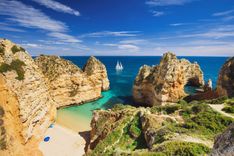2. Pousada Castelo de Alcácer do Sal, Alentejo
This pousada is inside a 12th-century castle that sits on a hill above the Sado River. It started out as a Moorish fortress, then became home to the Knights of Santiago, and now it’s a relaxed place to stay surrounded by Alentejo’s wide open landscapes.
You’ll still see the original stone walls, towers, and battlements, but the rooms are clean and modern inside. The restaurant leans into local ingredients with black pork, olive oil, and regional wines. You could easily spend a week-long Portugal itinerary here.
How to get to Pousada Castelo de Alcácer do Sal
It’s about 62 miles (100km) southeast of Lisbon via the A2 highway—around a one-hour drive (and a lovely Portugal road trip). From Lisbon Airport, it’s easiest to rent a car or arrange a private transfer. Buses also run from Lisbon’s Sete Rios terminal to Alcácer do Sal, then it’s a short taxi ride up to the castle.
When to visit Pousada Castelo de Alcácer do Sal
Spring and fall are the most comfortable, with daytime highs between 65–75°F (18–24°C). Summer can be hot—often reaching 95°F (35°C)—but it’s still manageable with early morning or late afternoon outings.
Winter is quieter, with temperatures around 50–59°F (10–15°C), and the castle’s thick stone walls make for cozy evenings. Forfood, colder months usually mean richer, seasonal menus.
3. Pestana Palácio do Freixo, Porto
This Baroque palace sits right on the Douro River, just outside the city center. It’s an 18th-century building that’s been restored into a calm, upscale hotel. The inside is pretty grand—lots of painted ceilings and marble details—but it doesn’t feel stiff.
This is a lovely Portugal pousada. There’s a riverside garden, a pool with views, and a spa if you want to take it slow. It’s just a short drive or taxi into central Porto, so you can be close to everything but still have space to relax. The restaurant focuses on food from the north of Portugal and pairs it with local wines. Plus, you are close enough to Porto to explore the city (see our guide to how many days to spend in Porto).
How to get to Pestana Palácio do Freixo
From Porto Airport, it’s a 15-minute drive by taxi. If you're taking public transport, hop on the metro to Campanhã station, then it’s a short ride by taxi or bus to the hotel. You can also drive yourself—just head toward the eastern side of Porto along the river.
In summer, river taxis run to the hotel’s private pier, which is a nice way to arrive to this Portugal pousada.
When to visit Pestana Palácio do Freixo
Late spring and early fall—May to June or September to October—are great times to visit, with temperatures around 64–77°F (18–25°C).
Porto has a lot going on during these months too, including wine events and cultural festivals. Summer is warmer and busier, but still pleasant if you want pool time. Winter (November to March) is cooler and rainier, with daytime highs around 50–59°F (10–15°C), but the city feels festive and the palace is a warm place to return to at the end of the day.











